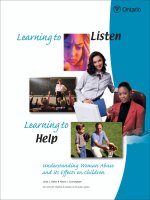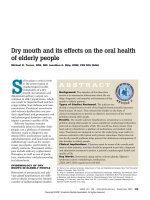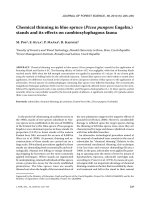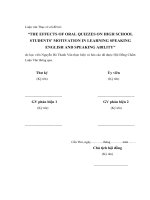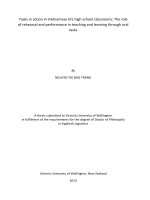MIbased teaching and its effects on EFL high school students autonomy (short cut version master thesis)
Bạn đang xem bản rút gọn của tài liệu. Xem và tải ngay bản đầy đủ của tài liệu tại đây (294.05 KB, 19 trang )
MINISTRY OF EDUCATION AND TRAINING
VINH UNIVERSITY
----- o0o -----
DƯƠNG THỊ THANH
MI-BASED TEACHING AND ITS
EFFECT ON EFL HIGH SCHOOL
STUDENTS’ AUTONOMY
FIELD: THEORY AND METHODOLOGY OF ENGLISH
LANGUAGE TEACHING
Code: 60140111
MASTER THESIS IN EDUCATION
Supervisor: Dr. Trần Thị Ngọc Yến
1. Rationale
OUTLINE
2. Aims of the Study
3. Research Questions
4. Literature Review
5. Research Design and
Methodology
6. Findings
7. Conclusion
1. RATIONALE
One of the
most
important
ways to
improve
learners’
autonomy
An
Students’
effective low
way to
autonomy
explore
students’
own
potentials
Ineffective
traditional
teaching
method
2. AIMS OF THE
STUDY
To find out
whether MIbased
teaching is
more effective
than the
traditional way
of teaching
lessons
To explore
whether
students can
improve their
autonomy
through MIbased lessons
To examine the
impacts of MI
teaching on
learners’
autonomy and
EFL high school
students’
English
proficiency
3. RESEARCH QUESTIONS
1. Will MI-based
teaching help
to develop EFL
high school
students'
autonomy?
2 How does MIbased teaching
affect EFL high
school
students’
English
proficiency?
4. LITERATURE REVIEW
4.1.1 Definitions
4.1 Multiple
Intelligences
4.1.2 MI quizzes
4.1.3 MI in education
4.1.4 MI in teaching
and learning English
4.2.1 Definitions
4.2 Autonomy
4.3 MI and
learner
autonomy
4.2.2 The roles of
autonomy in learning
4.2.3 Principles of
autonomy
4.2.4 Accessing
autonomy
4.2.5 Developing
learner autonomy
LITERATURE REVIEW
4.1 Definitions of MI
Gadner (1999) :
Barrington,
Kornhaber (2004)
et al
LITERATURE REVIEW
4.2 Definitions of autonomy
Holec (1981)
(Oxford advanced
learners
dictionary, 8th
edition)
5. RESEARCH DESIGN AND
METHODOLOGY
Research methods
Instruments for data collection
-Experimental
- Pre and Post tests
methods
- Pre and Post treatment
autonomy tests
Participants
54 students at 10th grade.
Effect of MI-based
teaching on students’
autonomy
6.
Findings
Effect of MI-based
teaching on English
proficiency
6. FINDINGS
6.1. Effect of MI-based teaching on students’
autonomy
Some considerable improvements in students’
autonomy after applying MI-based lessons
6. FINDINGS
Mean and SD of two groups
Items
Control group
Experimental
group
PrePostPrePosttreatmen treatmen treatmen treatmen
t
t
t
t
autonom autonom autonom autonom
y test
y test
y test
y test
Mean
157.6
162.11
153.6
181.63
SD
65.34
62.15
68.17
48.34
6. FINDINGS
6.2 Effect of MI-based teaching on English
proficiency
Increase of scores in English proficiency after applying
MI-based lessons.
6. FINDINGS
Mean and SD of two groups
Items
Control group
Pre-test
Post-test
Experimental
group
Pre-test
Post-test
Mean
32.11
31.8
33.37
36.7
SD
5.78
5.79
4.78
2.35
7. CONCLUSION
7.1 conclusions
1. MI-based teaching
is an effective
technique in
teaching lessons to
students.
2. MI-based teaching
has strongly
impacted on
students’
autonomy.
7. CONCLUSION
7.2 Implications
1. may be
used
effectively
with high
school
students at
any classes
2. be prepared
carefully
and interestingly
so that students’
strengths will be
certainly explored
more productively
3. design more
MI-based
lessons being
suitable to the
students’
innate
intelligences
7. CONCLUSION
7.3 Limitations
1. lack of
materials
2. short
period of
time
3. small
population
of
participants
7. CONCLUSION
7.4 suggestions
1. be carried out
with a large
number of
participants with
a longer
experimental
time
2. use more than
six MI-based
lesson plans to
increase the
reliability in the
treatment process


